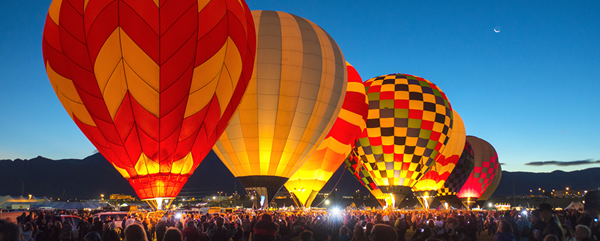Competition
Balloon contests
As a general rule, balloon competitions have nothing to do with speed or greater distance, but with precision.
International competition rules dictate a variety of objectives, which can translate into navigating with great precision to some local points, or flying in figures or angles over the landscape. Since a balloon has no type of propulsion and no rudder, this becomes a complex task: if the pilot wants to get somewhere, they have to know how to use the different wind directions at different altitudes in the best possible manner.
Sometimes the differences are considerable and results in the phenomenon that many competing balloonists call "a lot of driving.” But normally not more than ten to twenty degrees of direction of difference is registered and it becomes very difficult to reach a destination.
Or, thus "driving” up there, but only in atmospheric layers with a difference in altitude of two thousand meters, so it has to go up or down very quickly to find another direction.
International competition rules dictate a variety of objectives, which can translate into navigating with great precision to some local points, or flying in figures or angles over the landscape. Since a balloon has no type of propulsion and no rudder, this becomes a complex task: if the pilot wants to get somewhere, they have to know how to use the different wind directions at different altitudes in the best possible manner.
Sometimes the differences are considerable and results in the phenomenon that many competing balloonists call "a lot of driving.” But normally not more than ten to twenty degrees of direction of difference is registered and it becomes very difficult to reach a destination.
Or, thus "driving” up there, but only in atmospheric layers with a difference in altitude of two thousand meters, so it has to go up or down very quickly to find another direction.
As a general rule, balloon competitions have nothing to do with speed or greater distance, but with precision.
International competition rules dictate a variety of objectives, which can translate into navigating with great precision to some local points, or flying in figures or angles over the landscape. Since a balloon has no type of propulsion and no rudder, this becomes a complex task: if the pilot wants to get somewhere, they have to know how to use the different wind directions at different altitudes in the best possible manner.
Sometimes the differences are considerable and results in the phenomenon that many competing balloonists call "a lot of driving.” But normally not more than ten to twenty degrees of direction of difference is registered and it becomes very difficult to reach a destination.
Or, thus "driving” up there, but only in atmospheric layers with a difference in altitude of two thousand meters, so it has to go up or down very quickly to find another direction.
International competition rules dictate a variety of objectives, which can translate into navigating with great precision to some local points, or flying in figures or angles over the landscape. Since a balloon has no type of propulsion and no rudder, this becomes a complex task: if the pilot wants to get somewhere, they have to know how to use the different wind directions at different altitudes in the best possible manner.
Sometimes the differences are considerable and results in the phenomenon that many competing balloonists call "a lot of driving.” But normally not more than ten to twenty degrees of direction of difference is registered and it becomes very difficult to reach a destination.
Or, thus "driving” up there, but only in atmospheric layers with a difference in altitude of two thousand meters, so it has to go up or down very quickly to find another direction.
As a general rule, balloon competitions have nothing to do with speed or greater distance, but with precision.
International competition rules dictate a variety of objectives, which can translate into navigating with great precision to some local points, or flying in figures or angles over the landscape. Since a balloon has no type of propulsion and no rudder, this becomes a complex task: if the pilot wants to get somewhere, they have to know how to use the different wind directions at different altitudes in the best possible manner.
Sometimes the differences are considerable and results in the phenomenon that many competing balloonists call "a lot of driving.” But normally not more than ten to twenty degrees of direction of difference is registered and it becomes very difficult to reach a destination.
Or, thus "driving” up there, but only in atmospheric layers with a difference in altitude of two thousand meters, so it has to go up or down very quickly to find another direction.
International competition rules dictate a variety of objectives, which can translate into navigating with great precision to some local points, or flying in figures or angles over the landscape. Since a balloon has no type of propulsion and no rudder, this becomes a complex task: if the pilot wants to get somewhere, they have to know how to use the different wind directions at different altitudes in the best possible manner.
Sometimes the differences are considerable and results in the phenomenon that many competing balloonists call "a lot of driving.” But normally not more than ten to twenty degrees of direction of difference is registered and it becomes very difficult to reach a destination.
Or, thus "driving” up there, but only in atmospheric layers with a difference in altitude of two thousand meters, so it has to go up or down very quickly to find another direction.
back













